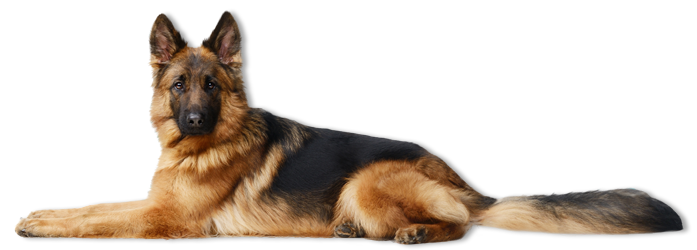German shepherd tail positions

"I wish my German Shepherd could speak to me; I would tell them how much I love them,"
say dog lovers, around the globe. Dog lovers also wish to understand their GSD's thoughts and emotions. Being able to communicate with their furry friends would help them better understand their needs and improve the dog’s overall quality of life. This article explores German shepherd tail positions.
While your dogs may not be able to talk, they can definitely communicate with you using their furry little tails…and that’s a fact!
German Shepherds' tails are essential to their communication system, conveying a wide range of emotions and responses. From excitement to anxiety, the position and movement of their tail can provide valuable insights into their mood and feelings. So even though they can't talk back, they can still communicate their love and affection uniquely.
The tale of tails: Here's everything you need to know about GSD tails:
German Shepherd Tail Description
Let's start with a general description of the tail of a German Shepherd, which is long and bushy, with a slight curve towards the end. It is carried low when relaxed and raised when alert. The tail serves several functions, including balance, communication, and as a means of expressing emotion.
German Shepherd Tail Length
The length of a German Shepherd's tail can vary, but it typically ranges from about 12 inches to 18 inches. Some breeders may dock puppy tails for cosmetic reasons or even for utility and safety, but this practice is controversial and banned in many countries.
Now that we covered the most important physical aspects of the tails let's get into the meaning behind different German Shepherd tail positions:
German Shepherd Tail Down
When a GSD’s tail position is down, it usually indicates a submissive or fearful state. This is often seen in dogs that are scared, anxious, or unsure of their surroundings. If your German Shepherd's tail is down, you must approach them calmly and reassure them.
-
Tail lowered.
A lowered tail usually means the dog is relaxed, but it's important to note that the tail is not between the legs in this position.
-
Tail lowered between the legs.
A lowered tail between the legs signifies fear, upset, or embarrassment, as the dog tries to make itself as small as possible.
German Shepherd Tail Curled Up
When a German Shepherd's tail is curled up, it can have several interpretations. In some cases, it may be a sign of excitement or happiness. However, if the tail is tightly curled and held high, it could also be a sign of aggressiveness. It's essential to pay attention to the dog's body language and other cues to determine the context of every situation.
-
German Shepherd Curled Tail Meaning
A curled tail in a German Shepherd dog can mean many things. A relaxed curled tail indicates a relaxed and happy dog, while a tightly curled tail indicates tension or anxiety. Sometimes, a German Shepherd may also curl its tail to protect its genital area when it feels threatened.
GSD’s tail: Fast wagging and wide.
If your dog is wagging its tail fast and wide, it usually indicates excitement, happiness, and energy, such as when a German Shepherd Dog greets their owner after a separation. The faster the wag, the more excited the dog is. Note that the tail is loose in this position.
GSD’s tail: Fast wagging but stiff.
A stiff and fast wagging tail held horizontally is an aggressive stance, indicating agitation or a threat. The dog is ready to defend itself if necessary.
GSD’s tail: Held high and straight.
A high, straight tail suggests confidence and control of a situation, indicating that the dog feels good. This high, stiff tail with a fast wagging tip generally means the pup is alert and aroused. Your puppy is feeling confident and enthusiastic and strutting its stuff.
GSD’s tail: held loose and horizontal.
A loose and horizontal tail shows that the dog is not ready to challenge a person or thing but is not afraid either.
GSD’s tail: Wagging slowly
A slowly wagging tail is slightly more affirmative than a loose and horizontal tail, indicating that the dog is trying to determine whether an approaching person is friendly or not. A slow wag is a neutral position; your dog is feeling neither dominant nor submissive.
In conclusion, understanding the different tail positions of German Shepherds is a critical aspect of communicating with and caring for these loyal and intelligent dogs. Please observe the dog's tail, body language, and other cues to determine its mood and needs. In doing so, we can develop a stronger bond with our furry companions and provide them the care they deserve.
Here is a quick German Shepherd tail positions cheat sheet for you
|
Tail Position |
GSD’s Mood |
|
Tail curled up: Loose |
Relaxed and happy. |
|
Tail curled up: Tight |
Tense or anxious. |
|
Tail down |
Scared, anxious, or unsure. |
|
Tail down between legs |
Fearful, upset, or embarrassed. |
|
Fast-wagging and loose |
Excited, happy, and energetic. |
|
Fast-wagging and stiff |
Aggressive stance: agitated or feeling threatened. |
|
Slow wagging |
Neutral position: neither dominant nor submissive. |
|
Held high and straight |
Confident, alert and aroused. |
|
Loose and horizontal |
Not ready to challenge, not afraid either. |


